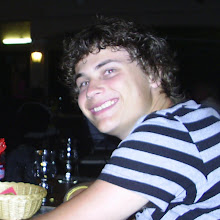Silence…
No car-hoinking…
Where are al the people gone to?
What’s with the snow…
Brr cold…
Everything in the
zondag 30 maart 2008
24/03 - Departure, arrival in the Netherlands
20/03 - Intervention
In the final week our task was to do some sort of intervention in our nagar. An intervention could be anything which ‘disturbs’ the daily life of the slum-dwellers. For example the group who got the 13th-coumpound as there nagar created a couch of bottles as a social element in the public space. A couch as the stereo type ‘public element’ in the public space.
What we did is to let the children in our nagar draw there ‘dream house’ and also what there father’s job is. What was quite interesting is that the children draw the exact same ‘ideal’ house as western children do. A hip roof, with a round window in it and two square windows symmetrically juxtapositioned with the entrance door in the middle of the façade. The house is positioned in a green hilly landscape with, of course, a beautiful smiling sunset. We pasted the results of our intervention al around our nagar on the walls of different slums. Our goal was to paste the drawings from the children on there dwelling were the live, but this was to difficult and to hectic in the end.

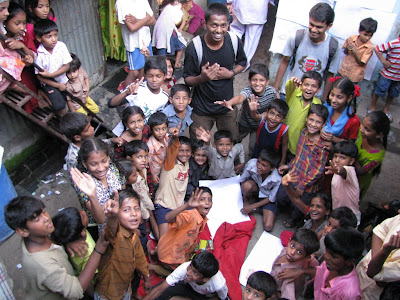


18/03 - Baptism
In our nagar, the Muslim-nagar, we were fortunate to experience the baptism of a boy and a girl. In the Muslim culture when a boy is being baptized, two goats are being sacrificed and for a girl, one goat. So in total three were sacrificed that day. The father of the boy explained to as the procedure of the sacrifice, the goat is being sacrificed according to ‘Hallal’. Which means that they cut the goats throat and let the blood flow out of it, so that the animal is clean. Which is different from ‘Hamar’ which means unclean.
After this explanation we joined the festivities and we got to ate the goat who had been sacrificed the same morning (and it tasted excellent :D)
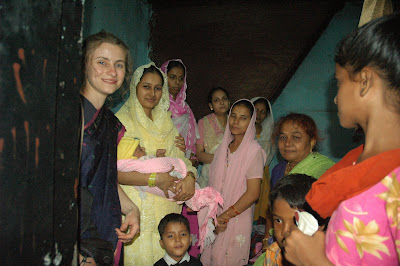


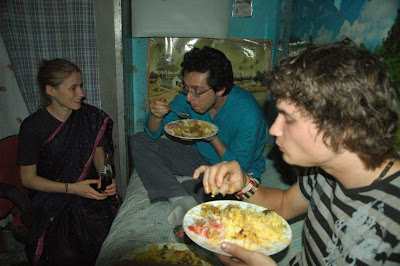
16/03 - Ellora caves
This weekend we went to


Food
10/03 - Mapping Dharavi main road
The object here was to map the more important roads in Dharavi. You have the 90ft road, the 60ft road and the Dharavi main road as the three main roads. Furthermore you have some smaller ones. We got the Dharavi main road as our road to analyze. We analysed it at three different times, during the morning, afternoon and the evening. What is most peculiar in general to say about the results is that this road never sleeps. At every time of the day there is activity going on.
Dharavi is a highly dens area of course, almost every square inch is being build upon. Except a cricket field which we came across. It was interesting to see that they leave this space open.

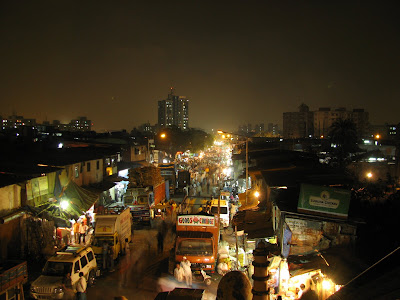


08/03 - Trainride
This day we visited some temples and some mosques. But the train ride that day was a very intense experience for me. The amount of people waiting is enormous and as soon as the train arrives you feel the tension of the people. The moment it stops it is every man for himself, trying the board in the limited time it stops. If you manage to get on the train the next goal is to stay on it, during the next stops it will make.
Compared to the
Video of the trainride

04/03 - Mapping the border
The object was to map the borders of Dharavi in a similar way we mapped


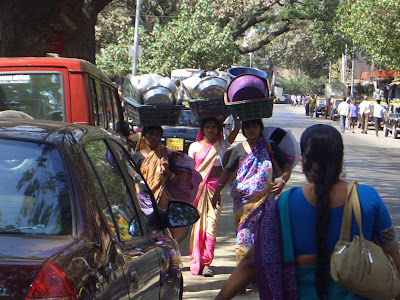
03/03 - Arrival


zaterdag 1 maart 2008
Bio-mapping
One victim was blindfolded and had a lie-detector on, one victim was high, blindfolded and had a lie-detector on and the last one (me) had no lie-detector on and was blindfolded. The guide not only guided, but also took notes from the things the victims were saying. Like:
“This is a very crowded place”, “I don’t feel safe here”, “I smell coffee”, “I hear children”, “Shit I stepped into a pile of water” Below is are final result and some impressions.
 |
| biomapping |
maandag 18 februari 2008
Photographing workshop
For me a 'good' picture is one where the object is somehow in the centre of attention on the picture. Usually in the centre. The picture isn't overexposed (of course this depends) or moved, anyhow the object should cleary be accentuated. So i took some pictures around one who was moved, one overexposed andso forth.
The one below I like best because ususally the object which you want to 'catch' on camera is in the centre of attention. What I tried to do is to annoy the audience with accedentially put a small piece of a building at the lleft bottom and also showing the window frame at the top, slightly tilted. People ask themselves, what is that?? O it's a piece of a builing, why is it in the left corner not centered and why is the window frame on the top visible.
"Post-deconstructivism"
To give an expample, we where faced with the security guys from FM who didn't allow us to pick certain materials, so it was al about being discreet as possible. An other feeling I personnaly had was that I felt really exposed. When we where dragging al kinds of materials people where looking weird and you could hear them think 'what the hell are they doing??"
We had a group of five people and we had a budget from E 50,- (E 10,- p.p.) to spend on food, the slum, interior etc.. We spend E 25,- on the slum and E 15,- on food. We spent E 20,- for the slum on a crappy Saran plastic material which afterwards was very expensive and there was to little on the roll. We had in mind to cover the airholes with the Saran. The other E 5,- we spent on a good joining material, rope.
zondag 17 februari 2008
zondag 10 februari 2008
Dharavi
week 1 thoughts
What also was interesting was the notion of how you think of your body. Do you use your legs only to move or do you really live ‘inside’ your legs. Becoming more aware of your lungs, breathing, smelling, touching, experiencing your body. Becoming more aware of the spaces you are in.
1.: The metropolis and Mental life - Georg Simmel (blz. 12) 19032.: The Overexposed City - Paul Virilio (blz. 544) 1984





